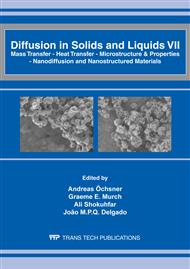p.243
p.249
p.255
p.261
p.267
p.273
p.279
p.285
p.291
Heat and Mass Transfer and Volume Variations during Drying of Industrial Ceramic Bricks: An Experimental Investigation
Abstract:
The purpose of this paper is to present an experimental study of brick drying. For the drying experiments, industrial brick (clay) was dried in an oven under controlled conditions of air velocity, air temperature and air relative humidity. The continuous drying experiments ended when the mass reached constant weight. In order, to obtain the balanced moisture content, each sample was kept under the same drying air temperature for 48 hours inside the oven. The tests were performed under atmospheric pressure. Results of the drying and heating kinetics and volume variations during the process are shown and analyzed. It was verified that air temperature has big influence in the drying rate during process. It was verified that the largest temperature, moisture content and stress gradients are located in the vertexes of the brick. The drying process happens in the falling drying rate period.
Info:
Periodical:
Pages:
267-272
Citation:
Online since:
April 2012
Keywords:
Price:
Сopyright:
© 2012 Trans Tech Publications Ltd. All Rights Reserved
Share:
Citation:


